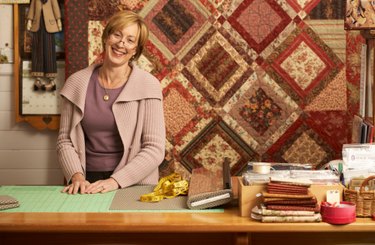Things You'll Need
Hankies, 7 to 10 per square
Iron and ironing board
Cutting mat
Rotary cutter
Ruler
Pins
Fabric, 14-inch square
Thread and needle or sewing machine
Batting
Quilt backing
Binding
Embellishments

While handkerchief quilts have been made for over a century, hanky panky quilts are a new addition to this area of quilting. Hanky panky is a quilt pattern designed by Cindy Brick, which essentially makes a crazy quilt of hankies. You can use old or new hankies for this quilt. Often, older hankies have more embellishment and design to them which makes them perfect for setting up quilt blocks. Old hankies can be found at antique shops and consignment stores. New hankies can also be used.
Step 1
Decide how large you want your quilt to be. For instance, a typical Full/Queen-sized bed quilt measures 90 inches by 90 inches. You would need thirty-six hanky blocks to make a quilt that size, plus binding.
Video of the Day
Step 2
Prepare your hankies. First, choose what the overall color theme is going to be, if you want one. Each block takes seven to ten hankies, so you can group them by color family, if you like. Once you have the hankies selected, fold them in half, then in half again and press into place.
Step 3
Place an ironed hanky on the cutting mat. Use the rotary cutter and ruler to cut the hanky in half on the diagonal. Cut so that the four corners are removed from the body of the hanky. When finished, you will have four separate corners to use on your blocks. Save the middle of the hanky to use as further embellishment on the quilt, or for another use.
Step 4
Place the 14-inch square piece of fabric on a flat work surface. This is the bottom layer of your block, and is the piece that the hankies get attached to. Have your pins close by, as it is time to start laying out the block itself.
Step 5
Place hanky corners around the border of the block first, with the finished edge of the hanky pointing towards the middle of the block. Overlap as needed. There is no hard and fast rule for laying this out, especially since hankies come in different sizes. You are sure to have a variety of sizes and edge treatments to work with. Once the border is the way you want it, pin it into place.
Step 6
Fill in the middle of the block with more hanky corners. Usually, these get tucked under the edges of the border, but that is not a rule. Lay the hankies in a manner that most appeals to you. You can also leave some of the background fabric showing. Pin the hankies into place.
Step 7
Attach the blocks together to make the quilt top, using the standard 1/4-inch seam allowance. The blocks can be attached directly to each other, or may be separated by strips of fabric. Separating the blocks will highlight each individual block, while attaching them to each other will give the impression of once large block that is made up of several upon closer inspection.
Step 8
Layer the quilt backing and batting, placing the hanky quilt blocks on top. Align edges and pin into place. Use pins often so that things do not shift during the quilting process.
Step 9
Sew the quilt together. You can use a specific stitching design, or you can follow along the lines of the hankies in each block. It is this quilting process that fuses all the layers together. Remove the pins as you go.
Step 10
Sew the binding on the quilt edges. This finishes the main portion of the quilt. Now it is time to add embellishments.
Step 11
Sew embellishments on the hanky blocks. These could be charms, buttons, ribbon bows, or anything else that strikes your fancy. You can also leave the embellishments off, if you prefer. When attaching the embellishments, sew only through the top layer of fabric.
Tip
You can also make pillow covers with hanky panky blocks.
Use a variety of hanky fabrics, such as silk, in addition to cotton.
Video of the Day